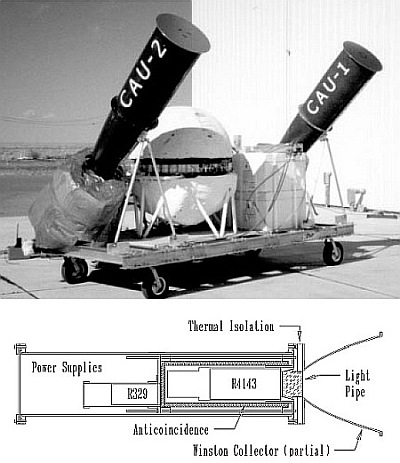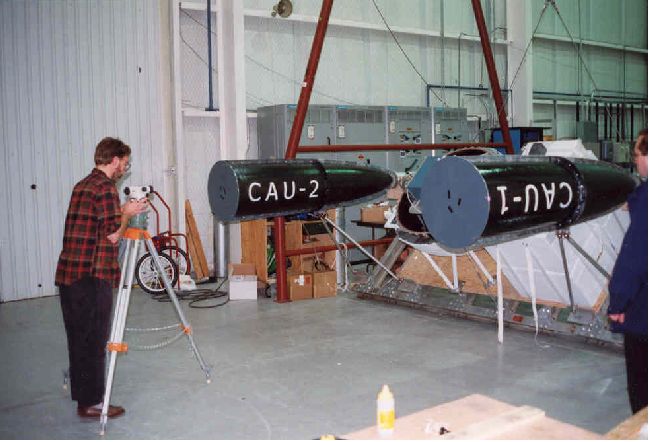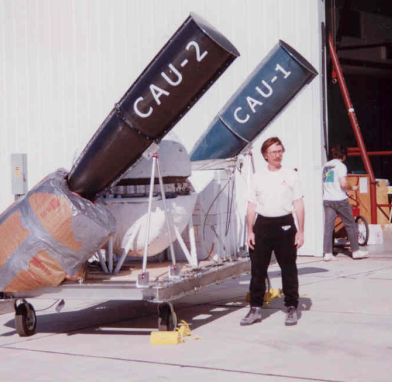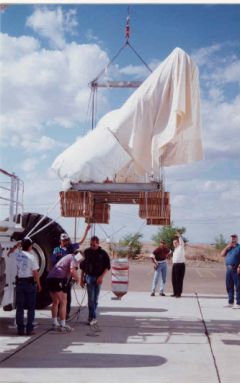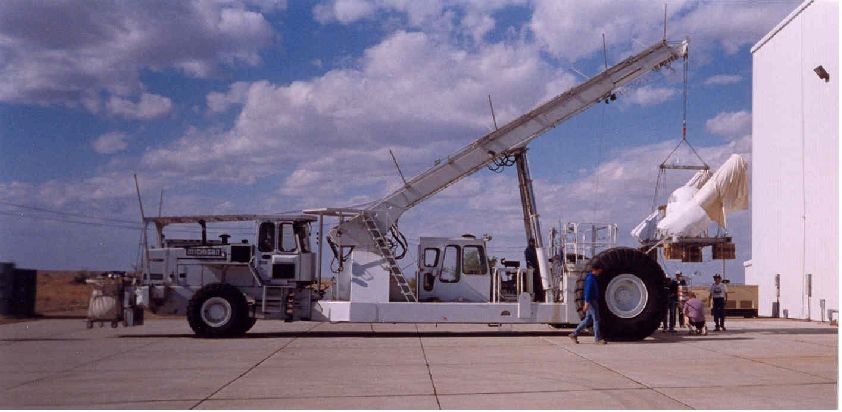Purpose of the flight and payload description
BACH stands for Balloon Air Cherenkov Experiment whose aim is to register very high-energy iron particles from cosmic rays using the Cerenkov light flashes, which these particles trigger in the uppermost layer of the earth's atmosphere. It was an instrument developed at the Department of Physics and Astronomy, University of Delaware with the collaboration of the Christian-Albrechts-Universität Kiel from Germany.
At left we can see the BACH instrument. The working principle is based in the premise that as a cosmic ray approaches the Earth, the atmosphere thickens and eventually the speed of the particle exceeds the speed of light in the ambient atmosphere, and the particle begins to generate Cherenkov radiation. As the particle penetrates into denser air, the Cherenkov angle and intensity increase. The first photons are emitted just on the axis defined by the particle path, but subsequent photons lie further and further from the axis when they reach any given depth in the atmosphere forming a circular spot or "pool" of light.
BACH was designed to improve the resolving time achieved by similar experiments in the past, thus to be able to use smaller, lighter optical components and therefore obtain a higher total geometry factor by mounting several detectors on the same payload. For this purpose BACH counted with high quality Hamamatsu R4143 three inch photomultipliers with a rise time of 1.8 nanoseconds, and electronics with commensurate capabilities. The cerenkov light was collected by using the so called Winston collectors, which were cup-shaped reflectors 209 cm long with a radius aperture of 24.3 cm. Each collector consisted of two upper and two lower sections, molded individually from carbon fiber epoxy composite material. A reflective aluminum coating was evaporated onto the sections, which were then assembled. They were uniformly sensitive to light within a viewing cone of 7.5º half-angle. Two collectors, separated on axis by 2.87 m, were operated in coincidence to reduce backgrounds due to numerous lower Z nuclei encountering the payload with small impact parameter.
As photomultipliers attached to the collectors must operate in very stringent conditions the development team constructed the so called Pressurized Optical Detectors (PODs) to operate the photomultipliers at one atmosphere, and couple them to the collectors via light pipes of Bicron UV transparent acrylic. The light pipes extend out from the PODs to allow thermal isolation of the PODs and collectors, while providing electrical insulation as well. Surfaces of each light pipe were polished and kept from contacting the POD structure except for a 0.32 cm tapered flange that provided a pressure seal. The PODs also contained R329 photomultipliers coupled to plastic scintillators that covered the detector photomultipliers and internal sections of the light pipes to serve as an anticoincidence shield against cosmic rays. Each photomultiplier received high voltage from an individual power supply, adjustable in flight.
Data was acquired with a Tektronics TDS640A digital oscilloscope which flew as part of the payload and captured 2 gigasamples per second in four channels simultaneously. The four channels were used to record data from the two R4143 photomultipliers and the two anticoincidence detectors. The oscilloscope along with a microcontroller-based unit used to interface it to the command and telemetry system, as well triggering electronics and other systems were housed in a egg-shaped pressurized vessel located between the two collectors. A flat platform served as gondola were the light collectors and pressurized vessel were mounted. At the bottom of the platform were located crush pads to soften the impact of the landing and a ballast hopper to control the flight altitude of the balloon.
Details of the balloon flight
Balloon launched on: 4/22/1998 at 2:01 utc
Launch site: Scientific Flight Balloon Facility, Fort Sumner, (NM), US
Balloon launched by: National Scientific Balloon Facility (NSBF)
Balloon manufacturer/size/composition: Zero Pressure Balloon 300.000 m3 - SF3-11.82-.8/.8-NHR
Balloon serial number: W11.82-1E-22
Flight identification number: 447N
End of flight (L for landing time, W for last contact, otherwise termination time): 4/22/1998 at 8:31 utc
Balloon flight duration (F: time at float only, otherwise total flight time in d:days / h:hours or m:minutes - ): 6 h 30 m
Landing site: 15 miles SSE of Sweetwater, Texas, US
The balloon was launched at sunset from Ft. Sumner, base in New Mexico, on April 22, 1998 and cut down ~6 hours later, yielding a useful exposure of 2.75 hours. Atmospheric pressure during the observation varied from 8.05 to 8.5 mb, corresponding to a threshold energy for iron of 2.2 x 1013 eV. The instrument collected 1793 triggers, each consisting of 250 ns (500 samples) of waveform from four channels: the two collectors and the two anticoincidence detectors. Since the signals resulting from the Cherenkov light were only a few nanoseconds wide, most of the waveform data were available for monitoring the skylight background. Expecting only a handful of true iron events, the trigger thresholds on the detectors were intentionally set to acquire events at a rate of approximately 0.1 Hz to allow detailed study of background sources.
External references
- A measurement of the flux of cosmic ray iron at 5x10 13 eV Astropart.Phys.16:387-395,2002
- Detecting Cosmic Ray Iron Using Balloon-Borne Air Cherenkov Detectors 24th International Cosmic Ray Conference, Vol. 3, held August 28-September 8, 1995
- NASA Balloon Flights (1989-1998) in NASA Historical Data Book, Vol. VII: NASA Launch Systems, Space Transportation, Human Spaceflight, and Space Science, 1989-1998
649If you consider this website interesting or useful, you can help me to keep it up and running with a small donation to cover the operational costs. Just the equivalent of the price of a cup of coffee helps a lot.

